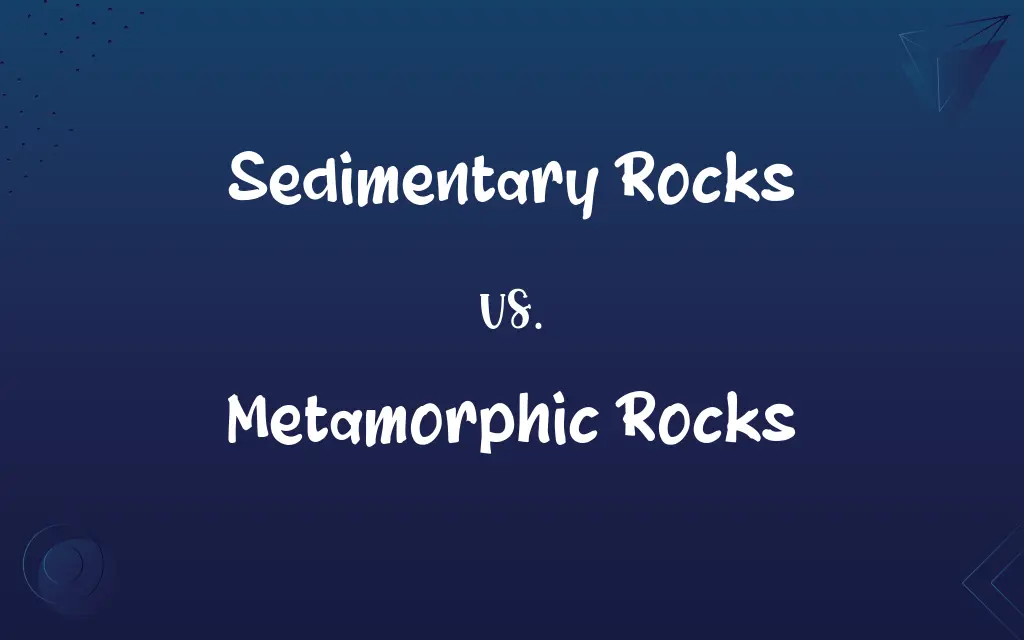Sedimentary Rocks vs. Metamorphic Rocks: Know the Difference

By Shumaila Saeed || Published on February 7, 2024
Sedimentary rocks form from sediment compaction and cementation, often containing fossils; metamorphic rocks form from existing rock transformation under heat and pressure.

Key Differences
Sedimentary Rocks are formed through the accumulation and compaction of sediments, such as sand, silt, and clay. Metamorphic Rocks, in contrast, originate from pre-existing rocks that undergo transformation due to intense heat and pressure within the Earth's crust.
Shumaila Saeed
Feb 07, 2024
The formation process of Sedimentary Rocks often involves water, where sediments are deposited, layered, and solidified over time. Metamorphic Rocks, however, do not require water for formation; instead, they are the result of existing rocks being subjected to extreme conditions, altering their mineral composition and texture.
Shumaila Saeed
Feb 07, 2024
Sedimentary Rocks can contain fossils as they often form in environments where living organisms are present, like lakes and oceans. Metamorphic Rocks rarely contain fossils, as the high heat and pressure conditions required for their formation typically destroy organic material.
Shumaila Saeed
Feb 07, 2024
Examples of Sedimentary Rocks include limestone and sandstone, known for their layered appearance. Metamorphic Rocks include slate and marble, which exhibit a more crystalline structure and often have a foliated or banded appearance.
Shumaila Saeed
Feb 07, 2024
Sedimentary Rocks are typically softer and less dense compared to Metamorphic Rocks, which are generally harder and more dense due to the intense conditions under which they form.
Shumaila Saeed
Feb 07, 2024
ADVERTISEMENT
Comparison Chart
Formation Process
Compaction and cementation of sediments
Transformation of existing rocks under heat and pressure
Shumaila Saeed
Feb 07, 2024
Environment
Often involves water (rivers, lakes, oceans)
Deep within Earth's crust
Shumaila Saeed
Feb 07, 2024
Physical Properties
Softer, layered appearance
Harder, foliated or banded texture
Shumaila Saeed
Feb 07, 2024
ADVERTISEMENT
Sedimentary Rocks and Metamorphic Rocks Definitions
Sedimentary Rocks
Includes rock types like sandstone and shale.
The desert landscape was dotted with red sandstone, a common sedimentary rock.
Shumaila Saeed
Jan 16, 2024
Metamorphic Rocks
Rocks transformed by heat and pressure.
Marble, used in sculpture, is a metamorphic rock formed from limestone.
Shumaila Saeed
Jan 16, 2024
Sedimentary Rocks
Rocks formed by the deposition of sediment.
The Grand Canyon's layers reveal various sedimentary rocks.
Shumaila Saeed
Jan 16, 2024
Metamorphic Rocks
Formed deep within the Earth’s crust.
The mountain range contains metamorphic rocks formed under extreme pressure.
Shumaila Saeed
Jan 16, 2024
Sedimentary Rocks
Can contain fossils from past organisms.
Fossilized shells were found in the sedimentary rock at the excavation site.
Shumaila Saeed
Jan 16, 2024
ADVERTISEMENT
Metamorphic Rocks
Originate from pre-existing rock types.
Slate, used in roofing, is a metamorphic rock that started as shale.
Shumaila Saeed
Jan 16, 2024
Sedimentary Rocks
Often found in water-rich environments.
Sedimentary rocks like limestone formed at the bottom of ancient seas.
Shumaila Saeed
Jan 16, 2024
Metamorphic Rocks
Exhibits foliated or non-foliated textures.
Gneiss, a metamorphic rock, displays a distinct banded texture.
Shumaila Saeed
Jan 16, 2024
Sedimentary Rocks
Characterized by distinct layers or strata.
The sedimentary rocks showed clear stratification, indicating different periods of deposition.
Shumaila Saeed
Jan 16, 2024
Metamorphic Rocks
Includes rocks like schist and quartzite.
The schist rock, with its shiny surface, is a common metamorphic rock.
Shumaila Saeed
Jan 16, 2024
Repeatedly Asked Queries
Where do sedimentary rocks commonly form?
In water bodies like lakes, oceans.
Shumaila Saeed
Feb 07, 2024
How are metamorphic rocks formed?
Through heat and pressure transforming existing rocks.
Shumaila Saeed
Feb 07, 2024
Can sedimentary rocks become metamorphic?
Yes, under intense heat and pressure.
Shumaila Saeed
Feb 07, 2024
Key feature of metamorphic rocks?
Distinctive foliated or banded appearance.
Shumaila Saeed
Feb 07, 2024
What textures do metamorphic rocks have?
Foliated (layered) or non-foliated.
Shumaila Saeed
Feb 07, 2024
What types of sediments form sedimentary rocks?
Sand, clay, minerals, organic matter.
Shumaila Saeed
Feb 07, 2024
Do metamorphic rocks have fossils?
Rarely, as fossils are usually destroyed during metamorphism.
Shumaila Saeed
Feb 07, 2024
How do sedimentary rocks form layers?
Through deposition of sediments over time.
Shumaila Saeed
Feb 07, 2024
What causes rock to metamorphose?
Heat, pressure, and chemically active fluids.
Shumaila Saeed
Feb 07, 2024
Are all metamorphic rocks the same?
No, they vary based on their protolith and metamorphic conditions.
Shumaila Saeed
Feb 07, 2024
Can metamorphic rocks form from igneous rocks?
Yes, through metamorphic processes.
Shumaila Saeed
Feb 07, 2024
Are all sedimentary rocks the same?
No, they vary in composition and texture.
Shumaila Saeed
Feb 07, 2024
What role does water play in forming sedimentary rocks?
Water transports and deposits sediments.
Shumaila Saeed
Feb 07, 2024
Share this page
Link for your blog / website
HTML
Link to share via messenger
About Author
Written by
Shumaila SaeedShumaila Saeed, an expert content creator with 6 years of experience, specializes in distilling complex topics into easily digestible comparisons, shining a light on the nuances that both inform and educate readers with clarity and accuracy.








































































